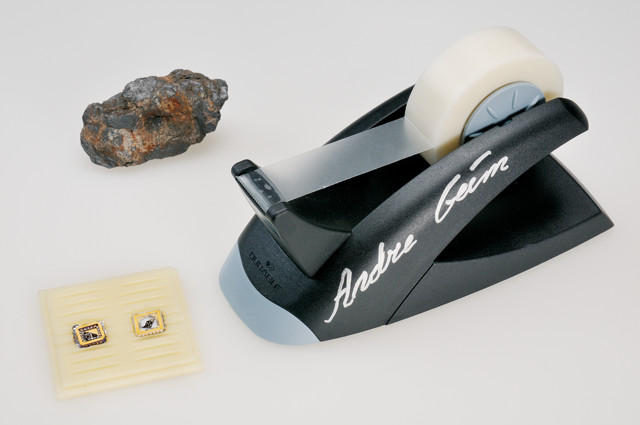
by U.S. Geological Survey Tuesday, June 12, 2018
Donald W. Olson, a mineral commodity specialist for the U.S. Geological Survey, compiled the following information on graphite, which is used in many industrial applications because of its unique properties.

In 2004, physicists Andre Geim and Konstantin Novoselov used cellophane tape to extract a single-atom-thick layer of graphene from graphite and transferred it to a silicon wafer — work for which they won the 2010 Nobel Prize in Physics. Geim donated this signed tape dispenser to the Nobel Museum. Credit: Gabriel Hildebrand, Nobelmuseet
Graphite is one of four natural forms of crystalline carbon, along with carbon nanotubes, diamonds and fullerenes. It is gray to black in color, opaque and usually has a metallic luster, although it sometimes exhibits a dull earthy luster. Graphite is soft, flexible, low-density, chemically inert and highly refractory. It is the most electrically and thermally conductive of the nonmetals.
Graphite occurs naturally in metamorphic rocks as lenses or layers of disseminated or massive flakes. Naturally occurring organic carbon may be graphitized at temperatures between 300 and 1,200 degrees Celsius. These temperatures could be reached during low-grade metamorphism or at the contact between an igneous intrusion and a carbonaceous body.
There are three types of natural graphite — amorphous, flake and lump. Amorphous — which refers to small crystal size, not to a lack of crystal structure — is the lowest quality and most abundant. Flake or crystalline flake graphite, which is less common and of higher quality, consists of many sheets of carbon atoms arranged in a flat honeycomb pattern stacked atop each other. Lump or vein graphite — which occurs in veins along intrusive contacts and is believed to be hydrothermal in origin — is the rarest, most valuable and highest quality.
Graphene, which can be produced from flake graphite, consists of a single atomic layer of carbon atoms arranged in a flat honeycomb pattern. It has 1,000 times the current-capacity of copper wire, is 200 times stronger than structural steel, has 10 times better heat conductivity than copper, and can be flexed 20 percent without sustaining damage — properties that give it the potential to make technology thinner, transparent, flexible and more powerful.
Graphite is used in batteries, brakes, moderator rods in nuclear reactors, chemically resistant materials, drilling-mud additives, electrical conductors, fuel cells, high-strength composites, lubricants, pencils, powdered metals, rubber and steelmaking.
For more information on graphite and other mineral resources, visit: http://minerals.usgs.gov/minerals
World production of natural graphite in 2014 was estimated to be 1.16 million metric tons. China was the leading producer, accounting for about 67 percent of the total.
Graphite demand has grown about 5 percent during the last decade, driven by the automotive and steel manufacturing sectors.
No natural graphite was produced in the U.S. in 2014, but production of synthetic graphite was estimated to be 129,000 metric tons, with a value of about $976 million.
In 2014, U.S. apparent consumption of natural graphite was 53,200 metric tons (valued at $57.5 million), accounting for about 5 percent of global natural graphite use.
Graphite is an outstanding dry lubricant and is highly resistant to corrosion and heat.
Lithium-ion batteries contain 10 to 20 times more graphite than lithium.
The average smartphone battery contains 15 grams of graphite.
© 2008-2021. All rights reserved. Any copying, redistribution or retransmission of any of the contents of this service without the expressed written permission of the American Geosciences Institute is expressly prohibited. Click here for all copyright requests.